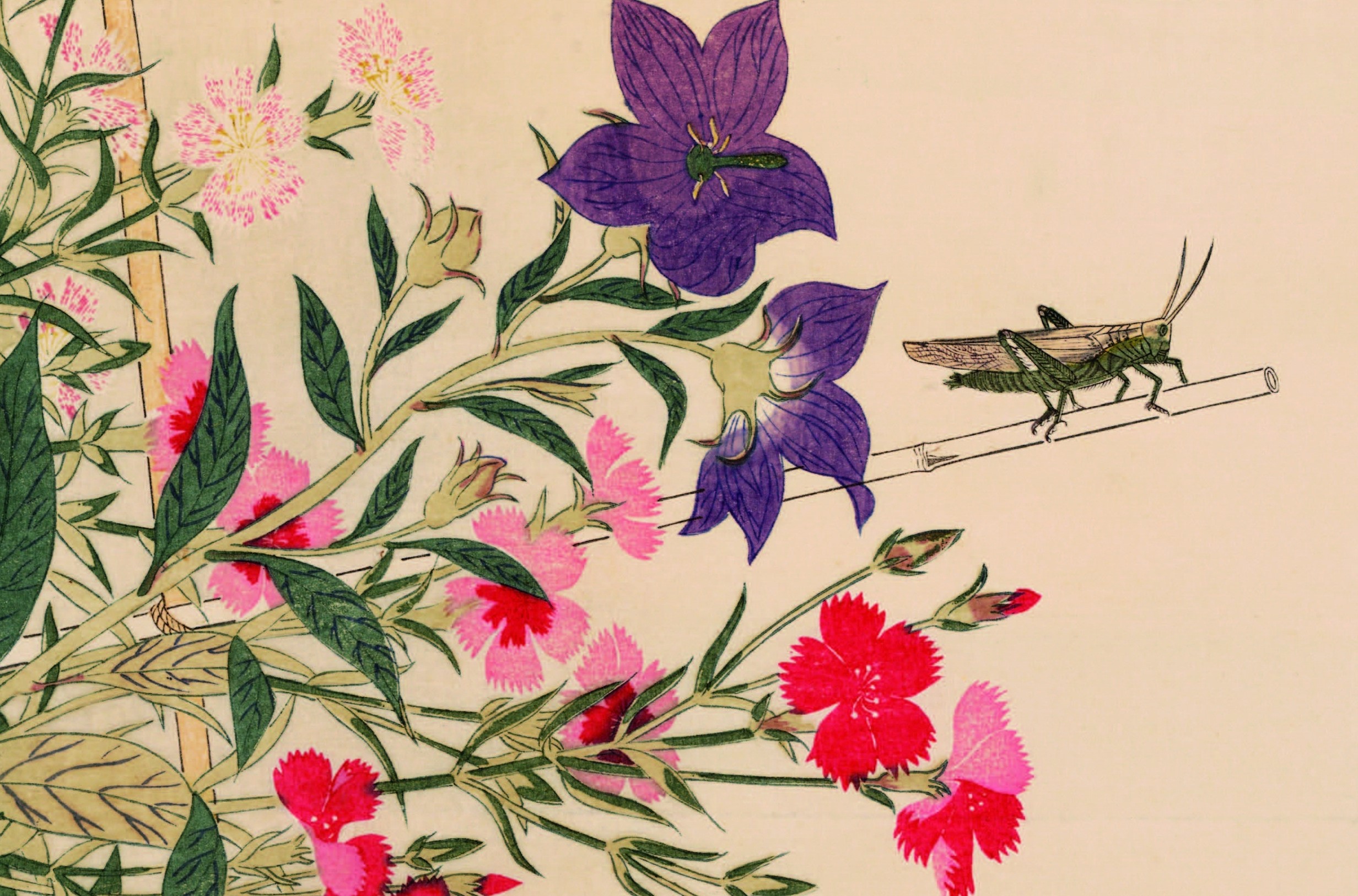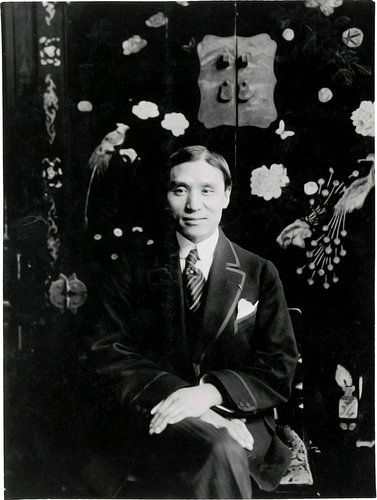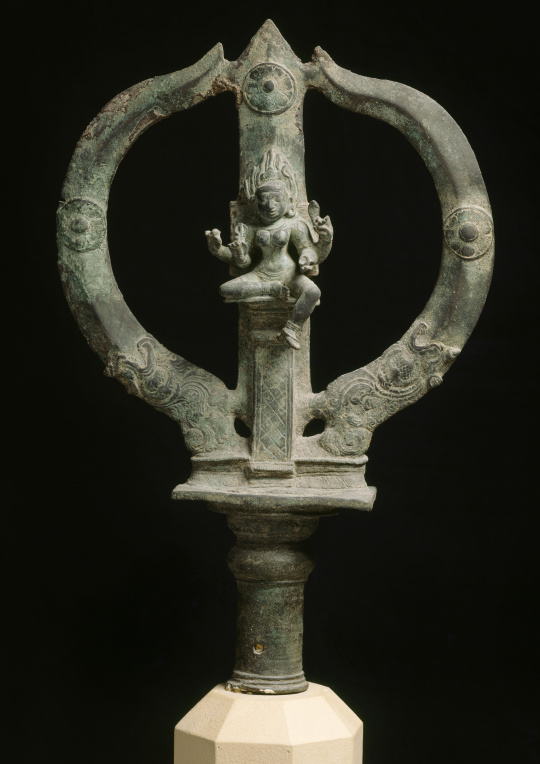
C. T. Loo (EN)
Private life
Known in Western countries as Ching Tsai Loo, or C. T. Loo, Lu Huan Wen was born in the village of Lujiadou, Zhejiang, China, on February 1st, 1880. Orphaned at age ten, Lu Huan Wen grew up with his uncle. As a teenager, Lu Huan Wen found employment in Nanxun, working as a cook for the wealthy Zhang family and then for the family’s son, Zhang Jingjiang (ZHANG Renjie) 張人傑 (1877-1950), who ultimately became the right-hand man of Sun Yat-sen (1866-1925) (Lenain G., 2013, p. 17).
In 1902, upon Zhang Jingjiang’s appointment as third councilor of the Chinese ambassador to France, Lu Huan Wen accompanied Zhang to Paris as his personal servant. Between 1902 and 1905, Loo’s employer enmeshed himself in the life of Paris and opened several businesses, including Ton-yun – later restyled as Ton-ying –, a Chinese-import store in the 8th arr at 17, La Madeleine Place. While still a personal servant to Zhang, Lu Huan Wen began working in the store and in 1905, accompanied his employer to Brussels, Belgium for the Universal Exposition of China. On that occasion, Lu Huan Wen received the decoration of Knight of the Leopold order (Lenain, G., 2013, p. 167).
Also, in 1905, Zhang resigned from his governmental post and became active with anti-Manchu endeavors. In 1906 he connected with Sun Yat-Sen and rose within the revolutionary circle and supported the Nationalist Government. Zhang’s connections gave him – and Wen – privileged access to high quality objects that he sold at Ton-Ying. Ton-Ying generated substantial profits, which Zhang invested in Sun Yat-Sen’s political movement. Wen, realizing even greater profitable opportunities, amicably left Zhang’s employment between 1907 and in the spring of 1908 and embarked upon an independent career selling Chinese art (Auboyer, J., 1957, p.309). Around the time of this separation, Lu Huan Wen restyled himself, adopting the name Lu Qin Zhai, which eventually morphed into Loo Ching Tsai, or C. T. Loo.
Loo began selling Chinese art objects, opening his own store. Loo found great success in selling Chinese and South Asian antiquities and grew his business into an international gallery with storefronts in London, New York, and Paris and warehouses in Beijing and Shanghai, China. Loo seemed to be in constant motion, traveling between three continents to manage his business. New York City and Paris, however, were his primary homes. In 1928, in recognition of his great impact on French culture and its artistic reputation, France elected him as an officer of the Légion d’Honneur, however, in 1950, Loo was unsuccessful in petitioning for French citizenship (Lenain, G., 2013, pp.121 and 224-232).
During his early years in Paris, Loo began a romantic relationship with a married woman, Olga Libmond (1876-1960), a hat maker with a storefront on the Place de la Madeleine. Uninterested in divorcing her husband, Olga arranged for her daughter, Marie-Rose Libmond (1895-1971) to marry Loo in her stead. On December 29, 1910 the couple wed (AP, actes de mariage du 1er arrondissement, 1910) and settled at 36 Washington Street, Paris and eventually welcomed four daughters: Monique (1913-2006), Denise (1915-2001), Olga (1917-2000) and Janine (1920-2013).
In the 1950s, Loo’s health began to weaken. In 1954, Marie-Rose Loo and C. T. Loo departed Paris, taking up a secondary residence in Cannes, which they referred to as « Yan Si Ko » (Yangxinge). Loo sought treatment for a motor neural disease at a clinic in Prangins, Switzerland. He succumbed to this malady and died on August 15, 1957 in Switzerland.
Professional life
In 1907, Lu Huan Wen left the employment of Zhang Jingjiang and styled himself as Lu Quin Zhai, which quickly morphed into Loo Ching Tsai or C. T. Loo. Equipped with nearly six years of experience at Ton-Ying & Company, Loo traveled to China to find investors for his own Parisian gallery.Loo secured three: ZHOU Wu Qi 吳啓周, owner of a silk shop in Shanghai; ZHAI Zhu Xu 祝讀齋, an antique dealer based in Beijing; and HUA Miu Xi, another antique dealer in Beijing (Lenain, G., 2013, p. 53-54). With this financial backing, Loo opened his own store, Lai-Yuan, based in the 9th arrondissement of Paris - between Boulevard Haussmann and Rue la Fayette - selling small-scale Chinese art objects. Shortly after opening, he and Li Hui Pi wrote pamphlet about silk entitled Faguo sishi dia cha lu (Lenain, G., 2013, p. 61
By 1912, Lai-Yuan was flourishing and in addition to selling works of art, began participating in loan exhibitions around Paris, including at the Musée Cernuschi. However, loans of Lai-Yuan stock happened under the name Société Chinoise Léyer (Musée Cernuschi, 1912, p. 90).
From roughly 1908 to 1914, Loo operated Lai-Yuan in Paris. In 1915, he restyled his business as C. T. Loo & Cie. To obtain inventory for his gallery he made annual buying trips to China. In 1911, with ZHOU Wu Qi, Loo established the export business Luwu Antiquities company with warehouses in Shanghai at 576 Nankin Street and in Beijing along Changxiang Street. This business supplied the majority of the inventory for Loo’s galleries.
Early in August 1914, Loo was in China procuring inventory for his Parisian gallery, when Austria-Hungary declared war on Serbia, marking the outbreak of World War I. Unable to return to Paris via railway, Loo rerouted his journey, booking himself passage abord the ocean liner, Chiyo Maru and traveled from Hong Kong to San Francisco, California, where he arrived on 31 August 1914 (NARA, Immigration Arrival Investigation Case File, 1884-1994). Loo traversed North America, crossing into Canada, and eventually arrived in New York City, where he witnessed the booming art market. In December, Loo returned to Paris but ventured back to New York in February 1915, establishing a New York branch of his gallery, Lai-Yuan (also known as Societé Chinoise Leyer), which he opened at 489 Fifth Avenue (NARA, Immigration and Naturalization Service, 1897-1957). Around this time, Loo also opened an English outpost of his gallery in London at 5 Thayer Street (Lenain, G., 2013, p. 93). From this point until his death, Loo operated both European and American galleries.
In March 1915, he mounted his first American exhibition, displaying Chinese ceramics, bronzes and paintings owned by the famed Shanghai collector, P’ang Yuan-chi (1864-1949) (American Art News, March 20, 1915, p.3). The American Art Galleries hosted Loo’s first – and only public auction during his lifetime – on May 5 and 6, offering 425 lots of porcelain, carved jades, agates, rugs, and carpets. Loo garnered quick success in the American market, earning nearly $10,500 through the American Art Galleries auction and eventually attracting high-profile clientele to his gallery, which he rebranded as Lai-Yuan & Company, including Charles Lang Freer (1854-1919), Eugene and Agnes Meyer (1875-1959; 1887-1970), members of the Rockefeller family, and Eli Lilly (1838-1898), to only to name a few.
The 1920s ushered in a golden age for Loo, as his inventory, galleries, and clientele began to rapidly expand. In early 1921, he closed Lai-Yuan & Company, New York and in April, reopened with the same moniker as his Parisian gallery, C.T. Loo & Company, New York. The western market for Chinese antiquities, especially in New York, was booming; C. T. Loo both encouraged and benefited from the enthusiasm. Inviting prominent sinologists – including Alfred Salmony (1890-1958), Paul Pelliot (1878-1945), and Alan Priest (1898-1969) – to study his vast inventory, Loo stimulated the scientific study of Chinese antiquities through publications and exhibitions. Not only did he sell numerous antiquities to curators, directors, and benefactors of America’s prominent museums, but he also made gifts – both of cash and objects – and worked closely with these institutions to develop collections of Chinese art. He also formed close relationships – as an advisor and vendor – with American university museums, including those at Harvard, Yale, and Pennsylvania State University, further promoting the western study of Chinese art history. Under the name of his New York Gallery, Loo organized temporary exhibitions of both his collection and objects from private collections.
C.T. Loo & Company reached peak success around 1928, when Loo received France’s Legion d’honneur and oversaw the construction and opening of his new, 8 million francs, Parisian gallery near the Parc Monceau at 48 Courcelles Street. Built by Fernand Bloch (1864-1945), the gallery assumes the exterior form of a bright red, Chinese pagoda. The interior is equally elaborate and transported Loo’s Parisian clients to the countries were his art originated. The Red Pagoda, as Loo referred to it, was a hub of activity, housing exhibitions, social gatherings, and scholarly events. Also, in 1928, Loo hired Frank Caro (1904-1980) as a gallery assistant and photographer in his New York office. Caro ultimately took on managerial responsibilities at C. T. Loo & Company, New York. In 1946, Loo transferred the management of C. T. Loo & Cie., Paris to his youngest daughter Janine Emmanuel Loo, as France enacted a law prohibiting foreign nationals from owning businesses (Lenain, G., 2013, p. 146).
Through the 1940s, Loo’s business began to decline as his supply chains in China began to weaken. Even though Loo, in 1945, received China’s highest level of recognition, earning the Order of Victory (Lenain, G., 2013, p. 185), his fate in China took a sudden turn. On July 29, 1948, following the orders of the Communist Government, the Shanghai Museum confiscated 17 crates of Chinese antiquities belonging to Lu Wu Antiquities Company that were bound for Paris (Lenain, G., 2013, p.189). Shortly after this seizure, the Chinese government deemed Loo “an enemy of China,” accusing him of stealing Chinese art and depriving China of its cultural heritage. Loo defended himself, writing in the journal Art News, that he never removed objects from sites, rather he purchased antiquities on the open market. He further defended his actions, noting that the works he sold would “be preserved for posterity” around the world. Loo championed his sale of Chinese antiquities, stating:
I firmly believe that all works of art have no frontier. They go around the World as silent ambassadors, enabling other people to understand the great culture of the Chinese and China. (Art News, 1950)
The Chinese government did not view Loo’s activities favorably and forbade him from returning to the country. Shortly after this declaration, the Shanghai Municipal Committee of Relics Management confiscated more than 3000 objects that remained in Luwu’s Shanghai warehouse (Zheng, C., 2003, pp. 414-415). These dramatic events led C. T. Loo to change his business model.
After the seizure of his Chinese inventory, Loo closed C. T. Loo & Company and began operating exclusively as C. T. Loo, INC. In March of 1950, he formally announced his retirement from C. T. Loo & Company and a liquidation sale of his New York inventory. At this time, he operated as C. T. Loo, INC., separating his personal and business assets. For unknown reasons, Loo changed his mind and decided that his galleries should carry on. On September 1, 1952, Loo reopened his galleries as two separately functioning branches in New York and Paris. Frank Caro, his assistant for more than 25 years managed the New York branch as C. T. Loo Chinese Art and Janine Emanuel-Loo continued managing the Parisian gallery, C.T. Loo & Cie., Art Ancien de Chine with the assistance of Michel Berudeley (1911-2012)
After 1952, Loo partially retired, though he continued to correspond with clients, encourage purchases, and advise both the managers of the New York and Parisian galleries. In 1953, C. T. Loo began – but did not complete – writing his memoirs with the assistance of Jeannine Auboyer (1912-1990), curator of the National Asian Arts Museum — Guimet. In this unfinished manuscript, Loo recounts – albeit in an embellished manner – his pioneering efforts in the sale of Chinese antiquities.
After Loo’s death in 1957, his legacy carried on. The Loo family inherited C. T. Loo & Company, New York and Paris and the galleries operated under the management of Frank Caro and Janine Emanuel-Loo. Frank Caro renamed the gallery C. T. Loo Chinese Art. In 1961 a disagreement – the specifics of which remain unknown – between the Loo heirs and Caro, leading to the closure of C. T. Loo Chinese Art and an auction of the company’s stock at the Park Bernet Galleries. Caro purchased objects either through the sale or in a private agreement with the family and continued to sell Chinese antiquities, counting objects that C. T. Loo originally brought out of China amongst his stock. Operating as Frank Caro Chinese Art, clients continued to refer to Caro’s gallery as C. T. Loo & Company until its closure in the 1980s. In Paris, Jeanine Emmanuel-Loo continued to steward the gallery, known interchangeably as C. T. Loo & Cie, Art Ancien de Chine; C.T. Loo & Cie., Arts d’Asie; and Galerie C. T. Loo & Cie. In 2002, the Loo family decided to sell the Pagoda and its contents through Christie’s, however, at the last moment chose not to proceed. The pagoda, however, remained closed (Lenain, G., 2013, 255). The C.T. Loo business empire officially ended with this closure, but the legacy of his endeavors continues.

The galleries and the collection
C. T. Loo featured Chinese, South Asian, and Southeast Asian objects in his galleries, however Chinese antiquities accounted for the bulk of his inventory. Accumulating objects dating to around 1766 AD through 1911 CE, Loo did not discriminate in terms of the age, material, or function of an object; his collection included stone sculpture, architectural ornament, jade objects, jewelry, bronzes, ceramics, paintings, textiles, and furniture. His collection was also diverse in quality and value, allowing him to appeal to those with modest budgets and no budgets at all.
With the fall of the Qing dynasty in 1911 and the resulting domestic and international conflicts the new Chinese Republic encountered, imperial and private collections were on the open market. It was a primetime to buy and sell Chinese objects and in 1911, Loo and ZHOU Wu Qi established the export business Luwu Antiquities Company with warehouses in Shanghai and Beijing. Loo and Zhou established an intricate trading networks centered around Luwu warehouses, which provided accommodations for traveling amateur merchants – often agricultural laborers who unexpectedly uncovered antiquities– and professional dealers, such as TAI Jun Tsei 戴潤齋 (1911–1992; born Dai Fubao). The warehouses would also dispatch employees to acquire antiquities in remote areas. Luwu Antiquities would stockpile inventory and then exported it to France via the port at Shanghai, reportedly filling the entire cargo ships (Lenain, G., 2014, 105). Loo’s close association with Zhang Jingjiang provided him with connections in the Guomingdang government and it was, therefore, easy for Luwu to circumvent the few export regulations that were in place. Luwu Antiquities Company exported stock for Loo’s Euro-American galleries until 1948, when the communist government sanctioned the seizure of the company’s stock. The Chinese government cited Loo’s 1920 sale of the Tang Taizong horses to the Pennsylvania University’s Museum (now the Penn Museum) as grounds for seizing Loo’s inventory and declaring him an enemy of China (Lenain, G., 2013, p. 98).
By the 1920s, Loo also counted South and Southeast Asian sculpture as part of his inventory, dedicating the entire fourth floor of his Parisian gallery to its display. Loo’s trade networks in South Asia are not entirely understood, though scholars have identified one of Loo’s scouts as Gabriel Jouveau-Dubreuil (1885–1945), a Frenchman living in Pudcherry (Pondicherry), India (Kaimal, P. A., 2012, 133-135).
Loo did not acquire his all of his inventory in Asia. Rather, he had an expansive social and professional network in Europe and America that connected him with fellow dealers and collectors, which sold and consigned objects with one another. Loo also purchased at auctions in New York, London, and Paris.

Related articles
Collection / collection d'une personne

Personne / personne

